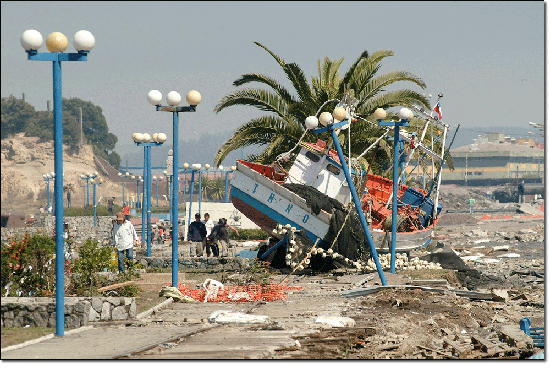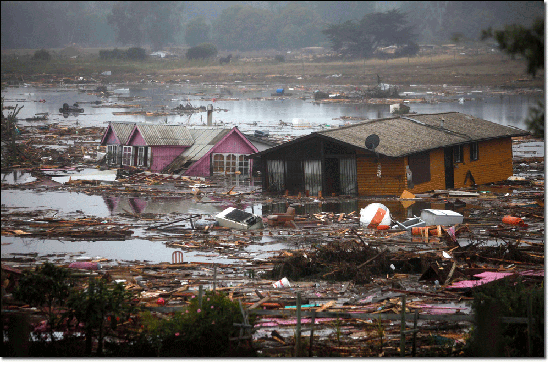Chile's Coastal Hazards
Tsunamis


The risk of Chilean coasts being affected by tsunamis is classified as high, according to ThinkHazard. The website says this means that Chile has a 20% chance of a potentially-damaging tsunami occuring in the next 50 years. An example of a tsunami that wreaked havoc over Chile is the earthquake and tsunami Maule.
Maule
On February 27th, 2010 a huge earthquake occurred off the coast of Maule in central Chile, just 70 miles from Chile's second largest city, Concepcion. A post about this earthquake/tsunami on the SMS Tsunami Warning website states, "It occurred on the subduction zone plate boundary at the Peru - Chile Trench where the oceanic Nazca Plate subducts beneath the continental South American Plate", resulting in a quake of 8.8 magnitude.
The map here signifies the epicenter of the quake as the red dot with the star, while the yellow dots represent areas that felt aftershocks of the quake until March 25th, 2010 (holy cow).
The post also says that the waves of the tsunami affected coastal areas Chile between the cities of Valparaiso and Valdivia, and brought less intense effects as far away as Coquimbo. It specifically devastated coastal towns between Tirua and Pichilemu (spanning over 500 Km, according to SMS) and damaged the port at Talcahuano.

Llico, Chile

Pellhue, Chile
The wave height of the tsunami peaked at 14m in the coastal area of Maule, and diminished to 4-2m near Valparaiso, and 2-4m near Cobquecura. It also affected the nearby Juan Fernandez islands, killing 8 people, as well as the coast of San Diego, California and Tohoku in Japan.
Despite Maule's widespread effects, the bulk of the damage was absorbed by Chile. The SMS post continues to say, "In Chile 525 people lost their lives, 25 people went missing and about 9% of the population in the affected regions lost their homes. According to Ministry of Interior data in May 2010, 124 of the 550 identified casualties and missing were attributed to the tsunami". The tsunami and earthquake combined destroyed 81,000+ houses, severely damaging another 109,000.
Warning System
Chile uses the Pacific Tsunami Warning System, and relies on the Hydrographic and
Oceanographic Service of the Navy (SHOA) as the only authority in the country responsible for managing the messages in case of a tsunami hazard. Chile also works with the Executive Council, which continuously studies abnormal variations in sea level associated with tsunamis, according to the European Emergency Number Association (EENA).
Sources:


Wow I did not know tsunamis were that big of a hazard for chile. Reading your blog post and seeing the pictures you chose to show case gave me a very good perspective of what goes on when a tsunami hits and what should citizens do to stay safe.
ReplyDelete